
The Art of Being Alone This Above All p. 17 p. 8 Existential Terror and You What Started in a Small Room p. 18 p. 10 Killed by Kiwis Q&A Giving Yourself Grace p. 22 p. 13 volume 22 — issue 11 fortnightly student magazine

ART
Art by Natalie Williams & Gracie Kibort
Fortnightly Student Magazine
Volume 22 Issue 11
©2022 The Wake Student Magazine. All Rights Reserved.
Established in 2002, The Wake is a fortnightly independent magazine and registered student organization produced by and for students at the University of Minnesota. The Wake was founded by Chrin Ruen and James DeLong.
Disclaimer: The purpose of The Wake is to provide a forum in which students can voice their opinions. Opinions expressed in the magazine are not representative of the publication or university as a whole. To join the conversation email eic@ wakemag.org.
Editorial Production
Editor-in-Chief
Managing Editor
Cities Editor
Voices Editor
Online Editor
Copy Editor
Music Reviews Editor
Multimedia Producer
Multimedia Editors
Srihita Raju
Sophia Goetz
Vishalli Alagappan
Carter Starkey
Quinn McClurg
Abby Vela
Peter Nomeland
Ben Villnow
Natalie Aue
Kailee Baumann
Cities Interns: Sydney Peshon
Voices Interns: Devna Panda, Goamaar Paul
Features Interns: Maddie Roth, Joshua Kloss
Online Interns: Bianca Llerena
Copy Editors: Vern Nowakowski, Hana Handzija
Music Reviews Interns: Shanna Sivakumar
This Issue
Writers
Srihita Raju, Natasha DeLion, Marie Ronnander, Quinn
McClurg, Sydney Peshon, Maddie Roth, Gracie Kibort, Lennon Gray, Zoe Meyer, Abby Vela, Caroline Ray, Rogan Isbell, Peter Nomeland
Creative Submissions
Natalie Williams and Gracie Kibort, Zoe Meyer, Marie Ronnander
Executive Director
Creative Director
Finance Manager
PR/Ad Manager
Social Media Manager
Art Director
Web Manager
Distribution Manager Designers
Marie Ronnander
Laura Kuchar
Maggie Huang
Gracie Kibort
Makayla Hillukka
Natalie Williams
Brennan Neuser
Selam Gerezgiher
Makenna Larson
Mallory Paul
Kat Regas
PR/Ad Interns: Cheyney McKinney, Jacob Nelson
Social Media Intern: Caroline Ray
Art Interns: Sana Ikramuddin, Alex Kozak, Brooke Lambrecht
Art
1 Brooke Lambrecht, 2 Sana Ikramuddin, 3 Natalie Williams, 4 Zoe Meyer
Cover and Feature Art: Alex Kozak
Feature Spread Design: Kat Regas
Live at Bush Hall, The Record, The Super Mario Bros Movie, The Red Hot Chili Peppers 2023 Tour, Rat Saw God, and Welcome to the Carter Tour images from original sources.
The Wake Student Magazine 126 Co man Memorial Union 300 Washington Avenue SE Minneapolis, MN 55455
THE WAKE Pinterest
Instagram
Facebook
Wake Magazine Twitter
Web wakemag.org
@thewakemagazine TikTok @thewakemagazine
@thewakemagazine
@The
@the_wake
wink! one page magazine
Rainy Day Ideas
Here are some reader’s best rainy day ideas. Try them out in these late April Showers!
Go for a rainy run outside(as long as it’s not raining too hard) then come back, feel good about myself, and lay in bed for the rest of the day.
grab friends have a reading party! make sure to bring lots of snacks and keep that window partially open :)
Going on a walk in the rain and listen to a rainy day album. You could also do some kinda watercolor outside and if the rain falls on it, it’s like a part of the painting
Start a duolingo streak you likely won’t continue (unless!), write letters to your former delusionships, FaceTime a friend who lives in a di erent country whom you miss very much hot cocoa and making beats
Bake something and listen to Adele and Amy Winehouse
Movie and art night!
4 APRIL 25 – MAY 1
9
INSIDE UPCOMING EVENTS
This Above All: Guthrie’s Brutalist Take on Hamlet is a Must See At Home Yet Again
What Started in a Small Room Make the Golf Course a Public Sex Forest!
Again: a Movie Musical I wish I could See Again
Giving Yourself Grace
Love Letter to my College-Aged Self
The Art of Being Alone
Existential Terror and You A Double-Standard in Women’s Basketball
Ask Gracie Six Reviews
Killed by Kiwis Q&A
4/1 - 5/31
Book Arts Show
Visit the Friedli Gallery April-May during Gallery hours! The second annual book arts showcase celebrating the works of book artists all over the country.
943 7th St W
4/8 - 5/20
Hamlet at The Guthrie
One of the Guthrie’s classic productions, the haunting revenge story returns this spring under the direction of Joseph Haj.
818 S 2nd St
4/25 - 6/18
An American Tail the Musical at the Children’s Theatre Company
If you loved the 1986 film about the immigrant story of Fievel Mouskewitz, then you’re sure to enjoy this stage adaptation.
2400 3rd Ave S
4/27 - 4/29
Troilus and Cressida at the Guthrie
The U’s BFA program brings you a tragic love story caught in the crosshairs of the Trojan war.
818 S 2nd St
4/24 - 4/30
Playlabs festival at the Playwright’s Center
This festival showcases scenes from playwright fellows at the center and o ers writers to bring their works to life in collaboration with a team of local artists and creators.
2301 E Franklin Ave
5 THE WAKE
13 16 17 18 19 20 22
8
10 11
Letter from the Creative Director
Dear fellow Wake enjoyer,
As you gaze into that photo of me that looks like I’m holding in a sneeze, picture me smaller, sweatier, and high school-ier. As a child, I picked up hobbies and skills really quickly. I loved to learn. This talent (if you can call it that) led to my fixation on my graphic arts classes in high school. When my peers and teachers praised my work, it motivated me to work even harder.

When it came time to go to college, I knew the only possible plan was Graphic Design. I’ve gained valuable knowledge and a great community of classmates. Now, as I round out my four years, I look back on a lot of work I’ve done with disdain. If you’re an artist, have any artist friends, or just generally care for what you do, you know your biggest critic is you. I’ve struggled with perfectionism all my life, and for the longest time, nothing was ever good enough, so I was never good enough. I noticed a pattern of being proud of myself for a week, then hating what I created for the rest of eternity. Knowing this, I entered my senior year with one goal: be proud of myself for me, not my work. I still wanted to work very hard, but I needed to keep myself in mind.
Last February, I started as Creative Director. The level of responsibility required for this job was daunting, but I wouldn’t trade it for anything. Making mistakes in a design and not noticing it until 700 copies have been printed is very humbling, but, like, in a fun way. I’m proud of myself and the entirety of our sta for what we’ve accomplished as a collective. The Wake has given me invaluable experiences that will inspire my lifelong career, and I am forever grateful for that.
I’m gaining confidence and pride in myself and my mistakes. Our feature article this issue, Giving Yourself Grace, reminds me to love me for me. I think I’m still working on the concept of being someone outside of my work. Seperating myself from who I am as a designer has been di cult and I’m definitely not done. If you find yourself in a similar postion, I recommend letting yourself make bad work every once and a while. Just mess some stu up! Doing something poorly can be oddly freeing and I think it’s a great exercise in self growth. Celebrate your victories and appreciate your failures for what they are: proof that you’re alive. Love the little things, not just the things that make you money. Love your intimate self, not the person people percieve you as.
And with that oddly sappy ending, I must bid you adieu.
Stay weird,
Laura Kuchar Creative Director
6 APRIL 25 – MAY 1

THE WAKE
Zine by Zoe Meyer
This Above All: Guthrie’s Brutalist Take on Hamlet is a Must See
Call the noblest to the audience for Guthrie’s 60th Anniversary Edition of Hamlet
 BY SRIHITA RAJU
BY SRIHITA RAJU
Lights dimmed, a hush fell, and the audience held their collective breath, the same as it happened 60 years ago. When Guthrie Theatre opened its doors in 1963, Sir Tyrone Guthrie knew there was one play that would be perfect for the soon-to-be iconic theater company to begin with. Now, in 2023, Guthrie Theatre is celebrating its 60th anniversary with audiences by revisiting their favorite macabre Danish prince in William Shakespeare’s “Hamlet.” In case you haven’t read the story before, “Hamlet” is the tale of the Prince of Denmark who is struggling with accepting his king father’s death as he watches his uncle marry his queen mother and take the throne of Denmark. One night, while with his totally platonic best friend, Horatio, he is visited by his father’s ghost, who tells him that his death was no mistake, and Hamlet needs to seek revenge on his behalf.
This production of “Hamlet” takes a brutalist approach to stage design. A gray trapezoidal wall towers over the audience with four cutouts: one as a door opening onto a metal landing that connects to a spiral staircase, another door near the bottom of the staircase, and two tall slits in between that help cast long shadows downstage. I’ve only ever seen one other Shakespeare play at the Guthrie, the “Tempest”, so I assumed that traditional Shakespearean stage design was out of question, but I was still surprised by how plain and cold this one was in comparison. Once the actors
came onto the stage, it was immediately clear why this choice was made. If you’re unfamiliar, “Hamlet” is an emotional, dramatic, and theatrical (even by theater standards) kind of play. The cold backdrop was the perfect platter for the players to take command over. It allowed for the Late King’s Ghost to appear completely inhuman and terrifying, while also allowing for Hamlet’s monologues about death and morality to feel as if they’re being recited in a cold room alone.
It wasn’t just Prince Hamlet, played by Michael Braugher, and Old Hamlet, played by David Whalen, who shone on stage. Every single actor made you feel the emotions and arcs that their characters were going through. I found myself hanging on to every sentence and every movement from lights down to lights up. I found myself particularly enchanted by Regina Marie Williams’ strong and complex Gertrude, and Anya WhelanSmith’s portrayal of a heartbroken Ophelia.
One of the best parts of seeing any Shakespeare play in theaters is that audiences are always in for a surprise while waiting to see how each production decides to add their own touches to the play. This production was no exception. There was one specific choice that genuinely made me gasp out loud, and because I want you to experience the same thing, I will not be naming it now. Just know that while the dire circumstances
and depressed prince had me on the verge of tears the entire night, creative moments like this one are the ones that took me over the edge.
If there’s one thing I hope people understand about this play, and about Shakespeare plays in general, is that you do not need to be any certain type of person to fall wholeheartedly in love with them. You do not need to be an English major, a theater kid, or even familiar with Shakespeare’s work. There is a misunderstanding that the only way to read Shakespeare is to pretentiously dissect it for a grade. On the other hand, some think of the Bard’s plays as little more than bawdy humor. The truth, at least in my opinion, lies in the middle. Shakespeare is able to use relationship dynamics and precise language in a way that immediately connects centuries of readers to a single string of lines. In that same scene, a character can say something absolutely foul that makes high schoolers across the country sweat when they have to recite it aloud in class, but, nonetheless, makes them smile. Shakespeare can be daunting, complex, funny, lovely, perverse, dark, and inspirational all at the same time. Come in as you are, with your own worries and hopes and secrets, and see them reflected on stage in words older than the telescope, but stand to be just as revolutionary. The Guthrie’s 60th anniversary production of “Hamlet” runs until May 21st, and I cannot recommend highly enough that you attend.
8 APRIL 25 – MAY 1
CITIES 1
At Home Yet Again
Snuggled up in bed with my laptop for company, as FOMO creeps in
BY NATASHA DELION
College can feel like the only years you have to actually enjoy being alive. It’s a time where you can live carefree and not feel tied down by the responsibilities of being an adult.
On the other hand, this time period is accompanied by the stress that comes with having four midterms in one week or three essays due on the same night. Most of the time, the stress is not counterbalanced by the limited time you get to have fun.
I struggled with the fear of missing out, FOMO, pretty much every week last year. Having to stay in and study while all of your friends are hanging out is not a good feeling, but the amount of work I needed to do felt never ending. FOMO is a roller coaster and it manifested for me in the following four stages: fear, resentment, guilt, and acceptance.
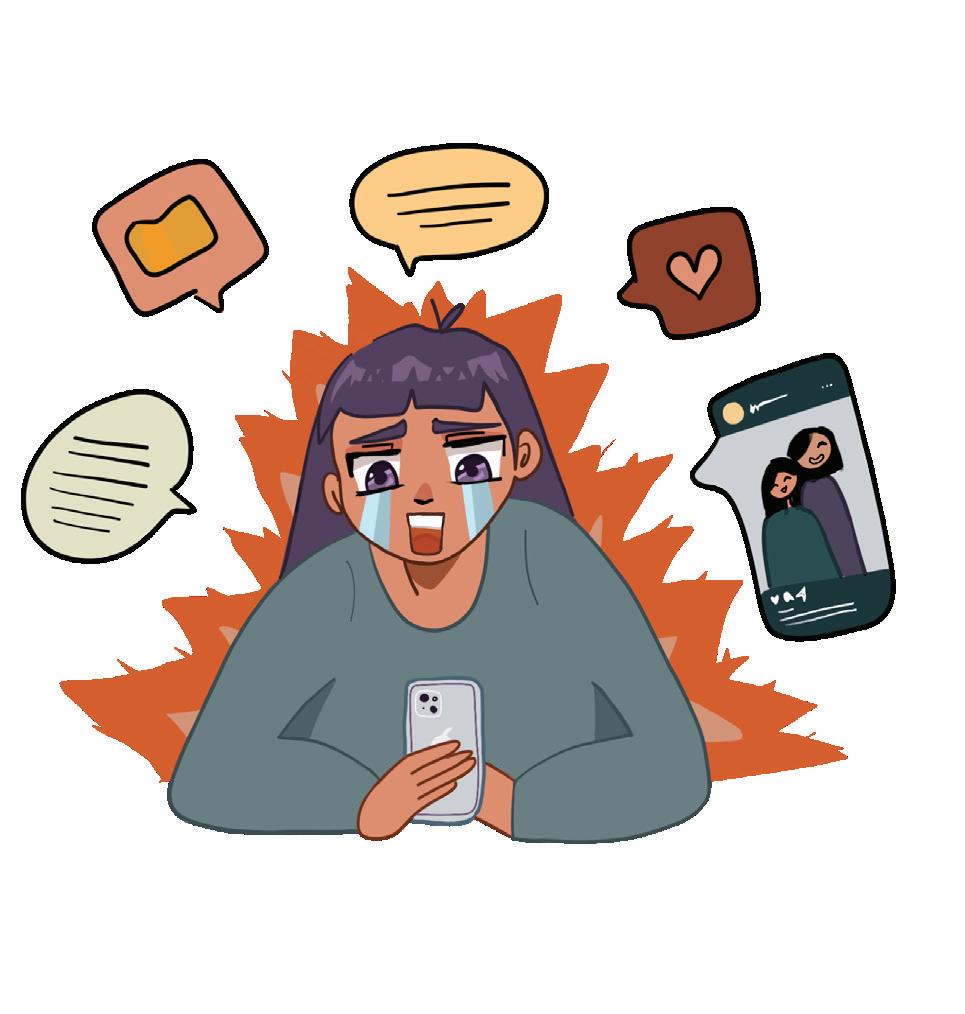
One aspect of FOMO is quite literally in its name: Fear. With fear came a variety of thoughts that reflected negatively on myself. I was afraid that some type of deep bonding would occur the one time I wasn’t there and that all my friends would get closer and leave me behind. Consequently, I would often think that my friends just didn’t want to hang out with me or that I wasn’t fun to be around. I feared loneliness and bitterness. I didn’t want to be the girl who sat alone and upset in her room every weekend. These fears soon turned into resentment.
Resentment is a hard emotion because you feel so angry at everything and everyone. I felt a lot of resentment towards my friends when they were having fun and I was sitting at home studying for hours on end. I didn’t want to accept that I had to feel miserable and they could have fun, but it was not their fault. Then I started resenting myself for being in this position in the first place and the universe for making my life so hard. It led me to believe that everybody and everything else were responsible for the way I was feeling, even though that makes absolutely no sense. I just didn’t want to accept the reason I was feeling this way was my own fault. Soon enough, I felt guilty for all the resentment I was carrying with me.
I blamed myself for my FOMO. I felt guilty for not going out and not spending time with my friends, even though it wasn’t something I had control over. I hated that I blamed my friends for the way I felt and soon internalized that blame. I was so down on myself for even thinking about those things. Guilt is such a strong emotion because it makes you feel like you’re doing something wrong even if it’s beneficial. Whenever I would say “no” to hanging out because I needed self-care time or I wasn’t feeling the best, I felt extremely guilty. I was lucky enough to have friends that understood that it wasn’t anything personal. They were more supportive than anything and always made sure to invite me the next time they made plans despite
however many times I refused.
As I’ve gone through my own healing journey, I’ve learned to accept my FOMO. I’ve come to the realization that spending time alone can be extremely valuable, even if it doesn’t feel like it at first. My friends never forgot about me and everything was the same as it always was. There is so much irrational fear that comes with it and it almost always works out in the end.
The time spent alone serves as a way to recharge, practice self-care, learn more about yourself or maybe even pick up a new hobby. You start to feel more secure in your friendships and in the relationship with yourself. You no longer need to worry about being left behind because you know that you’ll always have yourself to lean on.
Accepting your FOMO is not easy and most definitely does not happen overnight. I don’t think I intentionally accepted it or even set out to do so, but once you reach that point, life becomes peaceful.
9 THE WAKE
CITIES 2
What Started in a Small Room
Remembering where Minneapolis’s musical subculture started
BY MARIE RONNANDER
Lights dimmed, a hush fell, and the audience held tWhat I’ve come to love about the Twin Cities is the outright musical veneration pocketed throughout the community. We have a melodic melting pot here creating sounds that constantly push the labels defining a genre. Yet, within this world of harmonies, fine fractures form between the history of our city’s music and the final product on record. The roots of the cities’ music are being transplanted.
This culture loss has been the case for many sidelined or marginalized groups. History has a sneaky little tendency to be overwritten. But it’s not sneaky. It’s a historical erasure. This is how bluegrass was credited to Bill Monroe, where, in reality, his Appalachian twangs were inspired by Arnold Schultz, the son of a former slave. Even here, in the Twin Cities, there’s been a mass closure of buildings hosting rich history Black American musicians and femme voices. Entire artistic hubs have been quietly shut down with only those with memories of “the good old days” left to tell the tale.
Let’s zoom into the 1950s. The Cities were pretty segregated at this time, and finding a place to perform typically came down to whether a band was Black or White. Amidst this civil battle, Minneapolis established the Nacirema Club, The Cozy Bar, and The Flame. These three clubs became the top gig locations on the short list of venues open to Black musicians and feminine voices alike. Though small, they made history by dragging in huge crowds who hummed
and swung to the di erent versions of the “Minneapolis Funk.”
South Minneapolis’s Nacirema (so cleverly American spelled backwards) seemed to be a jack-of-all-trades type of location. By day, the club hosted your casual community meeting, maybe a Christmas party or sometimes even a fashion show. But on the weekend jazz nights, finding a place where your toes wouldn’t be stepped on was a (real) struggle. The club pulled in bands like Bobby Lyle group, Wee Willie Walker’s Solid on Down, and the legendary locals: Jimmy Jam and Terry Lewis. Even Prince was slid into the scene, dropping into sets for an occasional improvisation.
Flipping the compass to the North Side, the Cozy Bar was a hot spot for R&B with the master of harmonica himself, Mojo Buford, becoming a frequent visitor by the 1960s. The Cities’ very first Black-owned record label, “Black and Proud Record Company,” developed in the booming popularity of this genre. Some of their top bands like The Blazers or The Valdons swung by the Cozy Bar regularly to perform their hits. After transforming to the Ridgeway Supper Club, famous acts like Millie Jackson and Melba Moore spent their evenings under the disco lights.
Then, on the corner of Nicollet Avenue and East 16th, The Flame was where you went if you missed your horse and cowboy boots. This supper club had a unique niche in their representation of female voices on the scene. Ardis Wells and the Rhythm Ranch gals were a nightly yodeling crew known for their dangerous trapeze acts (which
ultimately had to stop because someone tattled to the city for safety concerns). The most well known acts of this bar were wild country women and Black American blues.
These three venues have another thing in common. They’re amongst the long list of historical BIPOC venues that have been shut down and shut up. Nacirema, as of 2018, stands as El Bethel Baptist Church while The Flame has devolved into a MediaXpress. The most interesting closure has to be The Cozy Bar’s violent pipeline into condominium apartments after facing parking lot murders.
These locations were epicenters for the arts where genuine legends began their climb to fame. Yet each of them closed without so much as a plaque commemorating their impact on our musical community. This erasure continued into the ‘90s hip hop scene with popular co eehouse venues closing because the crowds were “the wrong kind.” Co man Union’s history tab on their website doesn’t even mention that they were one of the only places that allowed Black artist hip hop music to be played.
We can’t forget the historical locations that inspired entire musical movements within our cities. We can’t forget that these places were Black, they were female, and that they let everybody through their doors for the sake of music. The rich history of Twin Cities musical subcultures should be documented and revered in more than just a handful of deep-dive articles so we don’t forget our past.
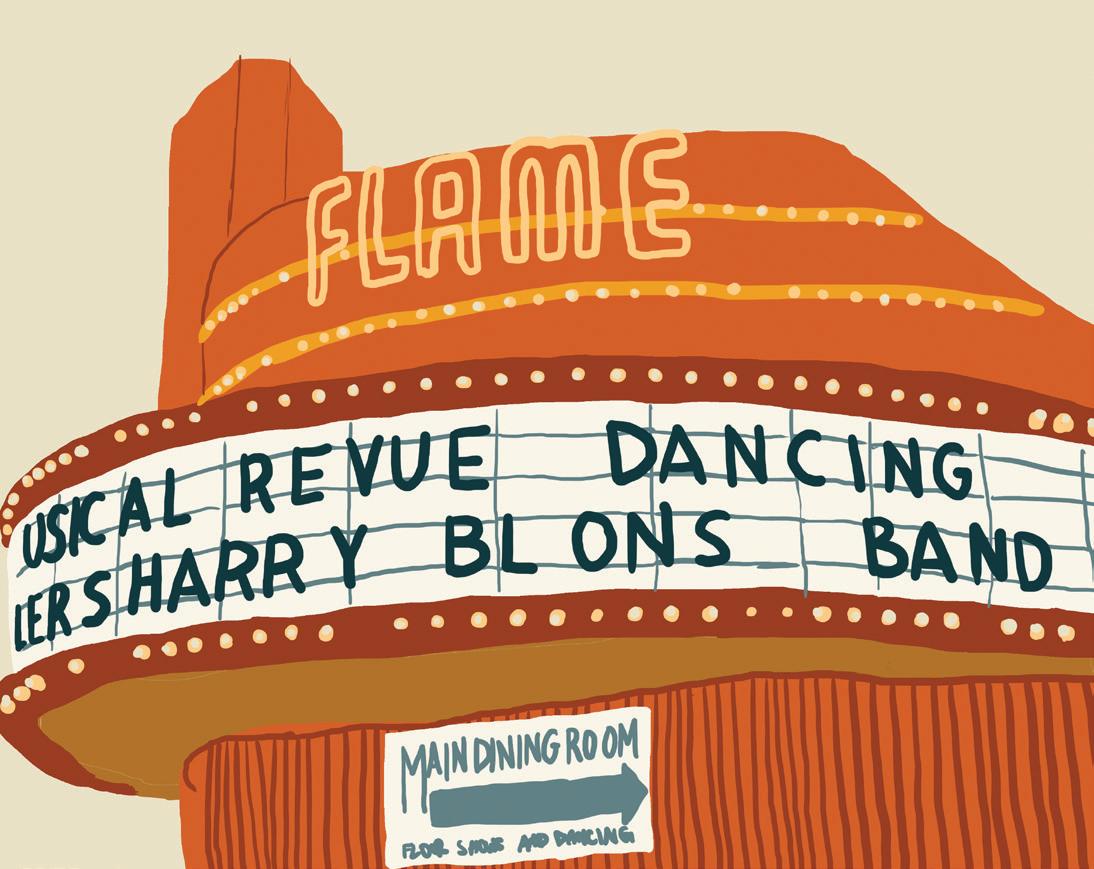
10 APRIL 25 – MAY 1 3
CITIES
Make the Golf Course a Public Sex Forest!
A movement, a book, a lifestyle
BY QUINN MCCLURG

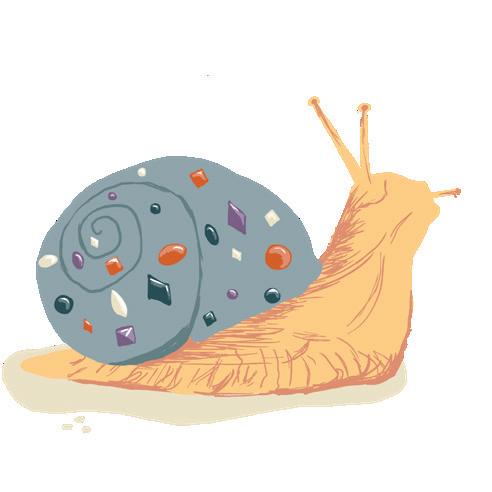
A tranquil marsh sat undisturbed in Southeast Minneapolis 101 years ago. Then, it was purchased by the Minneapolis Park and Recreation Board—this was the first action that violated this marsh. Gone were the fish and abundant wild rice, replaced by a water-wasting, chemical-smothered, thoroughly isolated piece of land, serving only as a pastime for the wealthy: the Hiawatha Golf Club.
Aside from the genocide it was built upon, Minneapolis has many more stories of tragedy: thousands of low-income households were demolished for roadways in the 70s, countless clubs and communities of queer folks were destroyed in the 80s, and, even today, thousands of people are systematically su ocated by food deserts, lacking consistent access to fresh, healthful food.
What if I told you there was a solution for all of this? Enter Lyn Corelle and jimmy cooper, two thoroughly involved Minneapolis residents, artists, and queer folk, holding no publishing experience and a dream—a dream mounting in popularity. First, a collage was made, then yard signs, followed by manifestos, stickers, and finally a book, all proclaiming in leather-clad, bold-face print, “MAKE THE GOLF COURSE A PUBLIC SEX FOREST!” It was an instant hit; knowledge of it disseminated far, culminating in a nationwide book-reading tour.
So, what exactly is a sex forest? Is it outlined within the book? A sex forest is whatever you dream it to be, and this communitysubmitted tome o ers 250 pages of possibility. Including tasteful poetry, delectable prose, thoroughly researched theory, and a feast of photography, everything within this book addresses our societal ailments through 30 di erent dreams of an indulgent, hedonistic, kinky food forest utopia, where all are welcome and included and “no perversions will be judged, not even vanilla heterosexuality.”
Whether these dreams are to be fully realized is uncertain; however, what is certain is this movement’s impact. Not only have Lyn Corelle and jimmy cooper donated all proceeds to Minneapolis food shares, but they have brought artists and enthusiasts from across the globe together, resulting in a community that values socio-political awareness, mutual aid e orts, and safe, enthusiastic, experimental sex. What’s more to love?
AGAIN: A moving musical I wish I could see again
A review of Nana Dakin’s new play
BY SYDNEY PESHON
Described as “a musical about what to do when sh*t gets real,””AGAIN,” a musical directed by Nana Dakin, tells a wholesome story about the relationships between two cancer survivors and an estranged sister. It follows Mai See, a Hmong memoirist, as well as Quest, an aspiring filmmaker, as they work together in making a documentary about how Mai went from cancer patient to accredited author, only for them to realize that the bigger story worth focusing in on is why Mai and her sister lost touch.
Despite the heavy themes of chronic illness and grief, “AGAIN” is a whimsical story that centers the power of community. From lucid dreams about a snail with a bedazzled shell to a music number about the challenges of using the bathroom, this campy and quirky musical was able to flawlessly blend absurdity with the serious emotional toll that cancer causes. Along with the compelling plot, this play showcased stunning performances from only four boisterous, zany, caregiving, and charismatic actors, as well as a minimalist set design able to make a bookstore and series of homes come to life.
This musical was held at Theater Mu, a charming theater that prides itself on empowering Asian Americans through theater, believing in universality being found through specificity. The name, Mu, is the Korean pronunciation of the Chinese character for the shaman, someone who connects the heavens and the earth through the tree of life. By providing a voice to the Asian American community, Theater Mu is able to o er insight and empathy of the Asian American culture and heritage to mainstream audiences, something vital when engaging conversation about diversity, something “AGAIN” did a perfect job of illuminating.
11 THE WAKE
CITIES 3 1

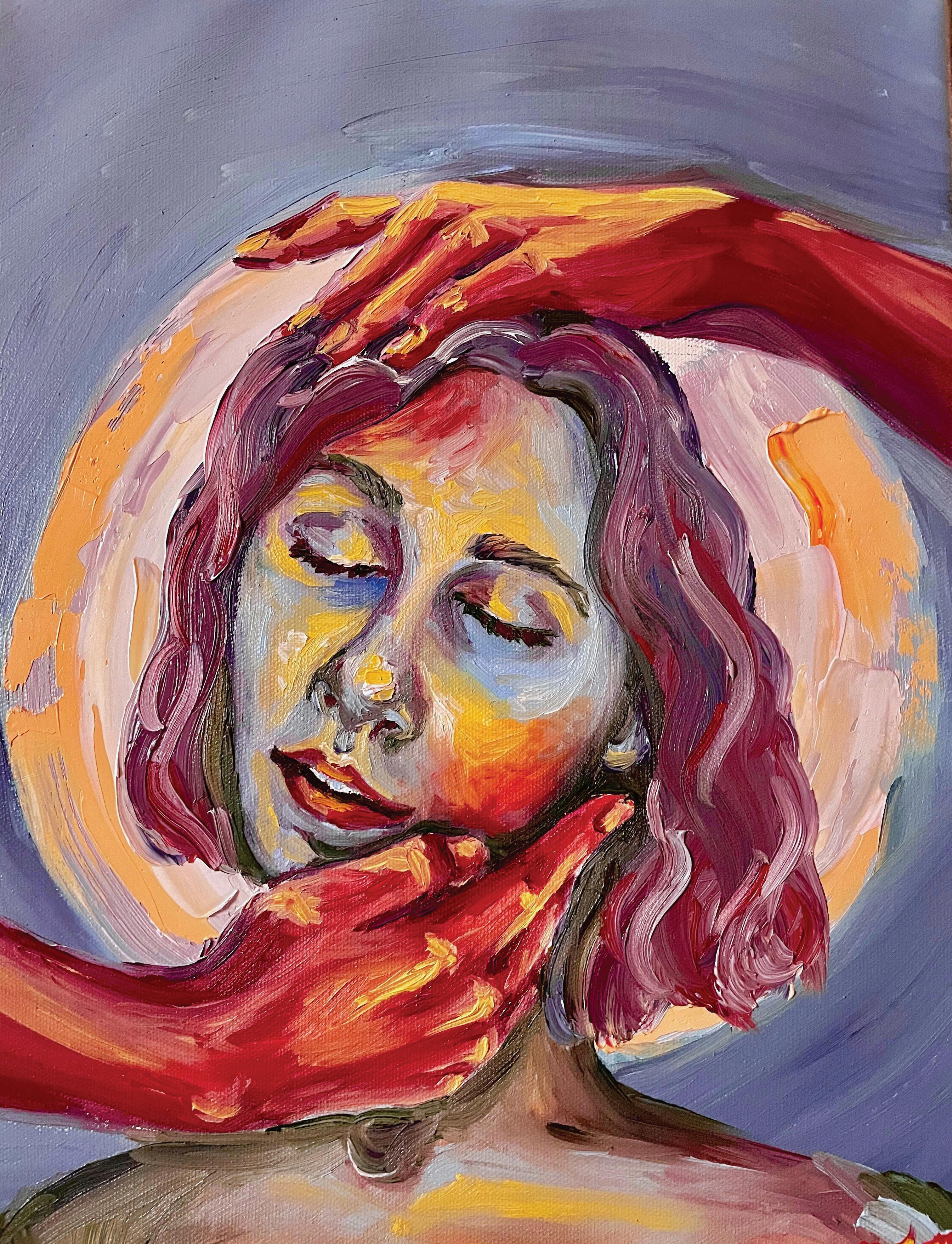
ART
Art by Marie Ronnander



When I was in high school, I was involved in two clubs. I played tennis and had a job on the weekends. Homework was never unbearable, and tests never stressed me out. I had friends I would go out with every weekend because we knew the weekdays were dedicated to school and spending time with family. I went on like this for four years.
When I came to college, all of that had changed. It was my year to be irresponsible and do everything I had wanted to do without anyone holding me back. And that’s what I did, loving every moment of life as much as the last. But sophomore year came around, and suddenly mountains of responsibility did not seem so far out of reach. Rent, groceries, normal house supplies, and laundry were expenses I did not have to worry about the year before. The only cloud hanging over my head was tuition, and now, it seemed like a raging thunderstorm constantly hovering over me.
In order to combat this, I decided I needed a job. Sorry, no, jobs. I picked up three di erent jobs, filling up every amount of spare time with work. I stopped going to class because attendance wasn’t required for any of them and began turning in assignments the day they were due. This wasn’t me; I wasn’t the type of student to do this. Once fall semester was over, I promised myself I was going to be better in spring. I made excuses about how I didn’t really enjoy my classes and it would be better in spring. I was going to be better.
But it only got worse. I got promoted at one of my jobs, meaning more responsibilities, and added an internship on top of everything else. My phone was constantly going o with notifications regardless of the fact I had turned o all social media notifications. Three apps had notifications on, and my phone was constantly buzzing from those apps. I have struggled with severe mental health issues for years and decided it would be a good idea to completely ignore my mental health so I could focus on school, work, and my friends. Every moment of my waking days were filled with class, meetings, seeing friends, being somewhere with someone at all times. I was never alone. And I never thought about my mental health.
About two weeks ago, my childhood best friend told me he was going to be in Minneapolis and demanded I see him. It had been three years since I had seen him last, so I immediately agreed. He has known me for ten years, being my personal therapist for six of those years. Nobody knows more about me than he does, but I had felt that I was in a good place for the first time in a long time. That’s exactly what I told him, and for a moment, he believed me.
“That’s great Maddie, but how are you really?”
I gave him an inquisitive look, telling him that was all. I was doing well and there was no more to it. He kept pushing me, asking how my mental health was doing. I paused, and without thinking, said “I don’t know.”
Since spring semester had started, I had ignored myself. I gave every piece of me to everyone and everything around me in fear of going down the same path I had gone down in the fall. After seeing my friend, I cried. I fell into complete and utter shambles.
The past two weeks of my life have been the busiest and unhappiest I’ve had in a while. I’ve had several exciting opportunities granted to me, but none of them have felt celebratory. Instead I have felt the weight of the world increase, and I have been su ocating a little more everyday.
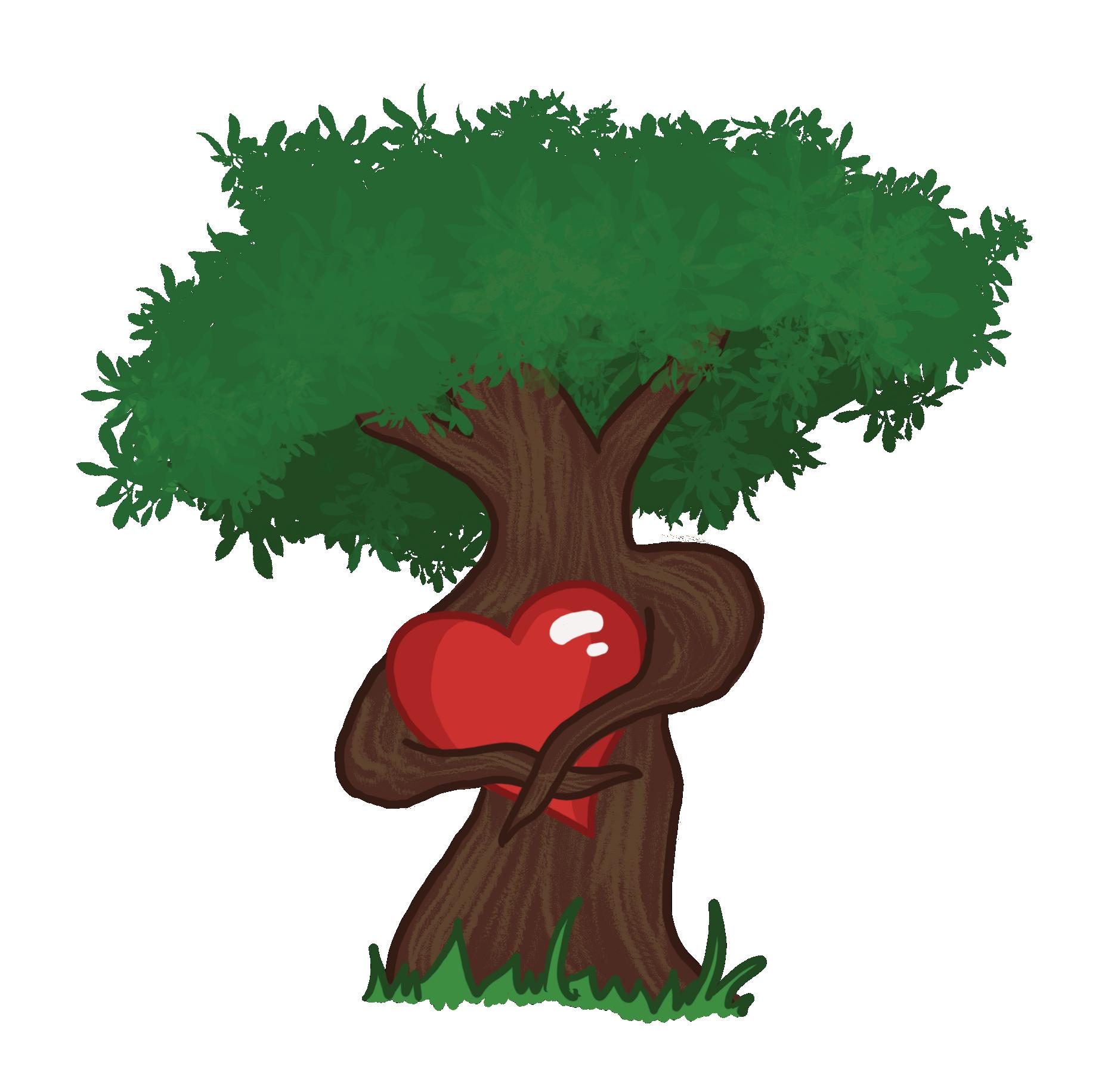

14 APRIL 25 – MAY 1
FEATURE
Every text, every email, every notification sent me further into having a mental breakdown. My breaking point was reached over a minor inconvenience: a bad grade on a test I thought I was going to do well on.
My best friend came over and held me in his tree branch arms, scared to move because he thought if he made one wrong move, I would shatter and never be able to piece myself back together. After sobbing for an hour, my best friend asked why I was so upset over one test. I had gotten a B on the exam, and he questioned why this is what had set me over the edge. It was at that moment I realized there was more going on underneath the surface: I was ignoring my body’s desperate cry for self care.

The glamorized version of self care includes a face mask, eating ice cream, and watching your favorite movie. If nobody will be honest with you, let me: this doesn’t work. This is a temporary solution to a deeper issue. Chemicals that are meant to “brighten my face” are no more helpful than eating a pint of Ben and Jerry’s chocolate chip cookie dough ice cream. A face mask will not resolve any mental health issue you are struggling with, and ice cream cannot take away the heartache of depression. Self care means turning o your phone for a day or taking time to be by yourself. Self care means crying your eyes out until the tears no longer stop falling and you finally feel
like there is a chance to breathe again. Self care means therapy.

Four mental breakdowns later, I realized it was time to take a break from everything. A friend of mine picked me up, and I decided to turn my phone o . I was with my friend for six hours and had my phone o the entire time. When I turned it back on, I had a slew of texts asking where I was and what I was doing. But for the first time in a long time, I didn’t care. It was the first time in two weeks where I felt like time was standing still. And it was amazing. Turn your phone o . Maybe tell people you’re doing it first, but turn your phone o .
Give your grace; be patient with yourself. Life as a college student is extremely busy, but you do not have to su ocate under the pressure of doing everything and anything all at once. It is okay to

side of Lake Michigan. I sat on the roof of my car and looked up at the stars, taking a moment to question if everything was going to be okay. It was at that moment I broke down for a fifth and final time. I screamed into the night, releasing all of the pain trapped underneath my tongue for the past two weeks and decided it was time to be nicer
Never be afraid to remove yourself from the world for a bit. When it feels like the world is caving in, give yourself grace. Allow yourself to feel everything and realize it is all temporary. You will not feel this forever. It may be a couple of weeks or months, maybe even years, but I promise you this is all temporary. But you will not get through this if you do not give yourself grace and patience. After screaming to the stars, I took three deep breaths and gave myself a moment to collect my
THE WAKE
FEATURE
Love Letter to My College-Aged Self
Got any suitcase recommendations?
BY GRACIE KIBORT
Approaching my final year in high school, I felt exhilarated. Terrified for the future, of course, but I was born with senioritis and suburban fatigue in my veins. The idea of shedding my skin like a snake, the moment I bound out of those stinky, hallowed halls yanked me through my harshest years to date. There was nostalgia, sure, but mostly respite. I somehow managed to liberate my teenage angst with nothing but my hand-medown SUV, and 2018 faded mom jeans. It was a time reminiscent of BookSmart, Ladybird, and Ferris Bueller’s Day O . When the day came, life briefly harmonized, and I felt lulled, like softness after a summer rain.
Chalk it up to climate change or the world descending into pure chaos, but peace was volatile. I find myself in a similar situation four years later, yet very much has changed. I am no longer antsy with anticipation of driving away from this chapter of my life. In fact, my knuckles are white as I clutch the emergency brake, refusing to budge.
Back in yesteryear (I believe it was September), I noticed a brightly colored graphic on Instagram, proposing that I value the current version of myself because she shan’t remain forever. Self-described as both anxious and a little superstitious; I took it as a sign. Whenever my mind wanders and I reflect on my high school years, I yearn to hug that girl. Certainly, she is no longer me, but nonetheless. This digital guidepost motivated me to enlighten myself and celebrate the most perplexing period of my life to date. As the graphic crossed my path,
I noticed growth, perseverance, friendship, and love. Unfortunately or fortunately, depending on how you view it, whatever era I’ve stumbled into is fleeting, I must bid her adieu.
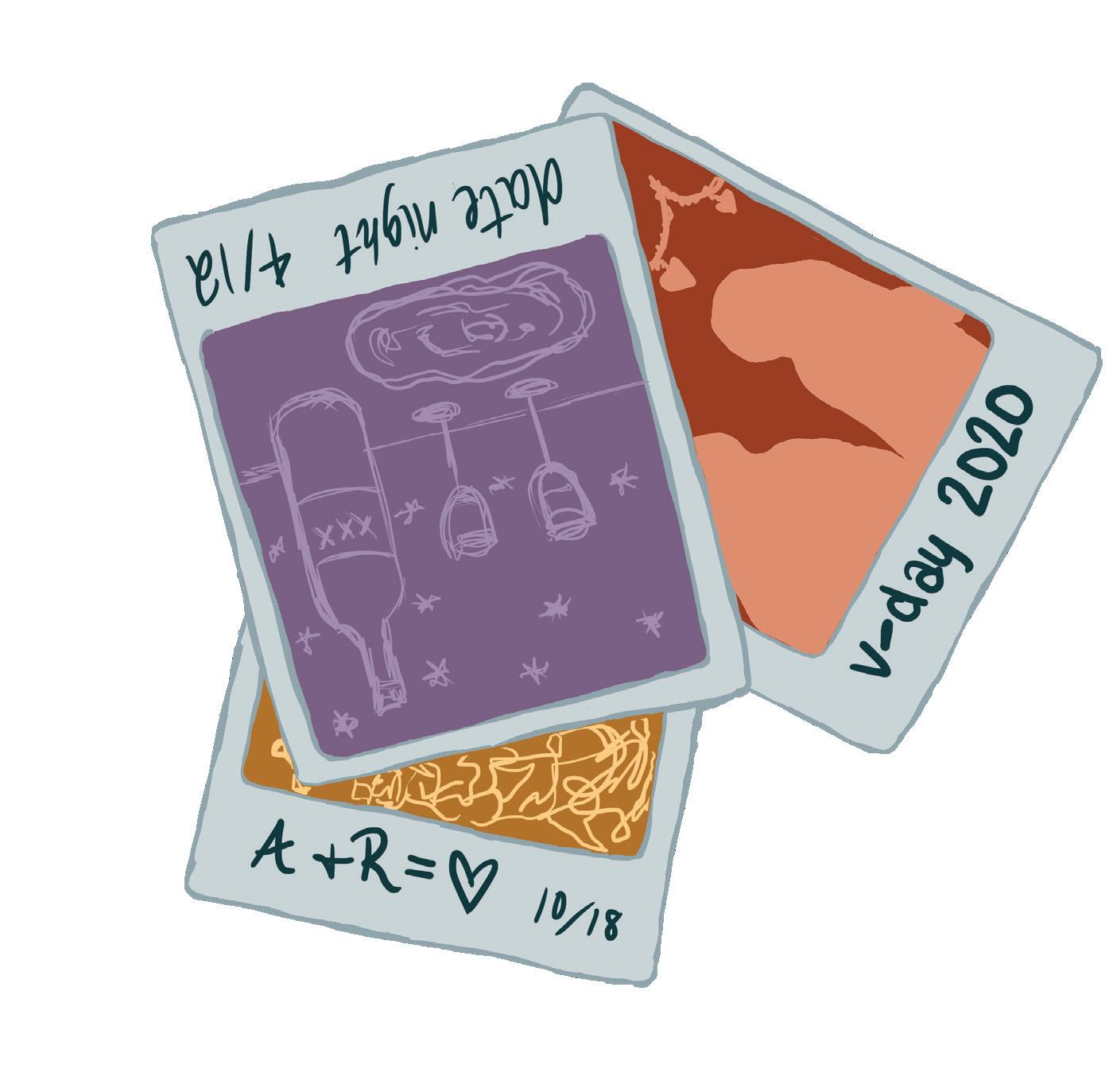

Yet as much as I wish to experience the turn of the seasons in Dinkytown like it’s Groundhog’s Day, I have come to realize that my college experience is like an old sweater. I recently found said sweater in the back of my childhood closet clutched to my chest. I sni ed the slightly dilapidated threads that reeked of the decrepit-closet stench. Eagerly, I tried it on but was instantly met with disappointment. The arms fit unevenly, the collar too stretched. I couldn’t bear to part with her but knew she wouldn’t be worn again. She will remain hanging solemnly in my closet, reminiscent of sweeter days, reeking of sentiment.
Why is there no post-grad packing list? I grew up watching shows of hoarders with my mother. We are adequately familiar with the structure: keep, donate/dump, and pile for the maybes. As I both figuratively and literally pack up my life, I must decide what shall remain and what shall be chucked into the garbage. For your convenience, I’ve divided it into categories.
Keep. I will retain my positive attitude and dedication to doing right by myself and by others. My Polaroid photo collection though has waxed and waned as friends come and go. Various
tapestry. Nightly routines of High–Low Hero and Wii Karaoke. The friendships I will willingly leave here. Dollar Tree holiday decor.
Dump. They are already blocked. Self-doubt and academic validation. The act of shrinking myself to appease others
Maybe. How do I determine what I need for the life I know nothing about? Many of my crop-tops are questionable. Some of those polaroids, too.
Confidently and unsurprisingly, I proclaim that I am a product of college metamorphosis. As graduation hurdles me with the speed of light, I want to raise a toast to the college version of myself, may she be folded nicely and tucked into a plastic bucket in the storage unit of my mind. She’s a keeper. For she may never be the same again but will reflect fondly on our memories together. L’chaim, Salut, Cheers.
16 APRIL 25 – MAY 1
VOICES
3
The Art of Being Alone
BY LENNON GRAY
Learning how to be alone is such a valuable and precious thing. It comes with growing pains, of course, given that as we get older we spend more and more time alone. There’s a natural fear of being alone. You might be unsure what to do with yourself and fear your thoughts might consume you whole. Constant solitude is often to your detriment, but occasional solitude gives you time to get to know yourself. You get time to process your emotions, self-regulate, and do self-care. When you actively choose to have time alone, you have the space to appreciate the mental and social benefits. Being alone does not necessarily equate to being lonely, especially if you purposefully set time aside for yourself. Having this time to recharge is vital to avoiding stress and burnout, as well as learning to be comfortable in your own company and better handle negative emotions.
It can be di cult to not feel lonely in your solitude–when you rely on others to enrich the experiences of life. We are undeniably social creatures, and total deprivation of social contact with others has extremely negative impacts on mental health. I am not advocating for total solitude and no socialization. It is equally as harmful to be entirely dependent on interactions with others. There are times when people will be unavailable, and you will have to learn to be alone. Focusing on the fact you are alone and cannot be with others will make this time feel worse than it is when it is in fact a great time to invest in yourself. Take time to do things you enjoy, engage in self care, and take yourself on
value your time alone.
It’s also relieving when you feel you must put on a show for others– you can be completely yourself. You’re not being judged, and you can do anything that brings you happiness without discomfort. You can let your mind wander aimlessly, and despite how intimidating that may sound, you may stumble upon new ideas, create art, write poetry, and so on. It’s exhausting to constantly perform, so let your mind and body be free for a bit every now and then.
Additionally, most restful and self-care activities occur when you are alone, and doing these activities with others might hinder just how restful they can be. The more you value this time, the more you prioritize your needs rather than putting them aside at your own expense for the sake of others. Having no obligations and nobody to impress is incredibly freeing. You can also be more picky with who you spend time with when you’re not alone. You can take time to reevaluate who you feel comfortable with. You get better at establishing healthy boundaries and become more emotionally mature because you value your time more.
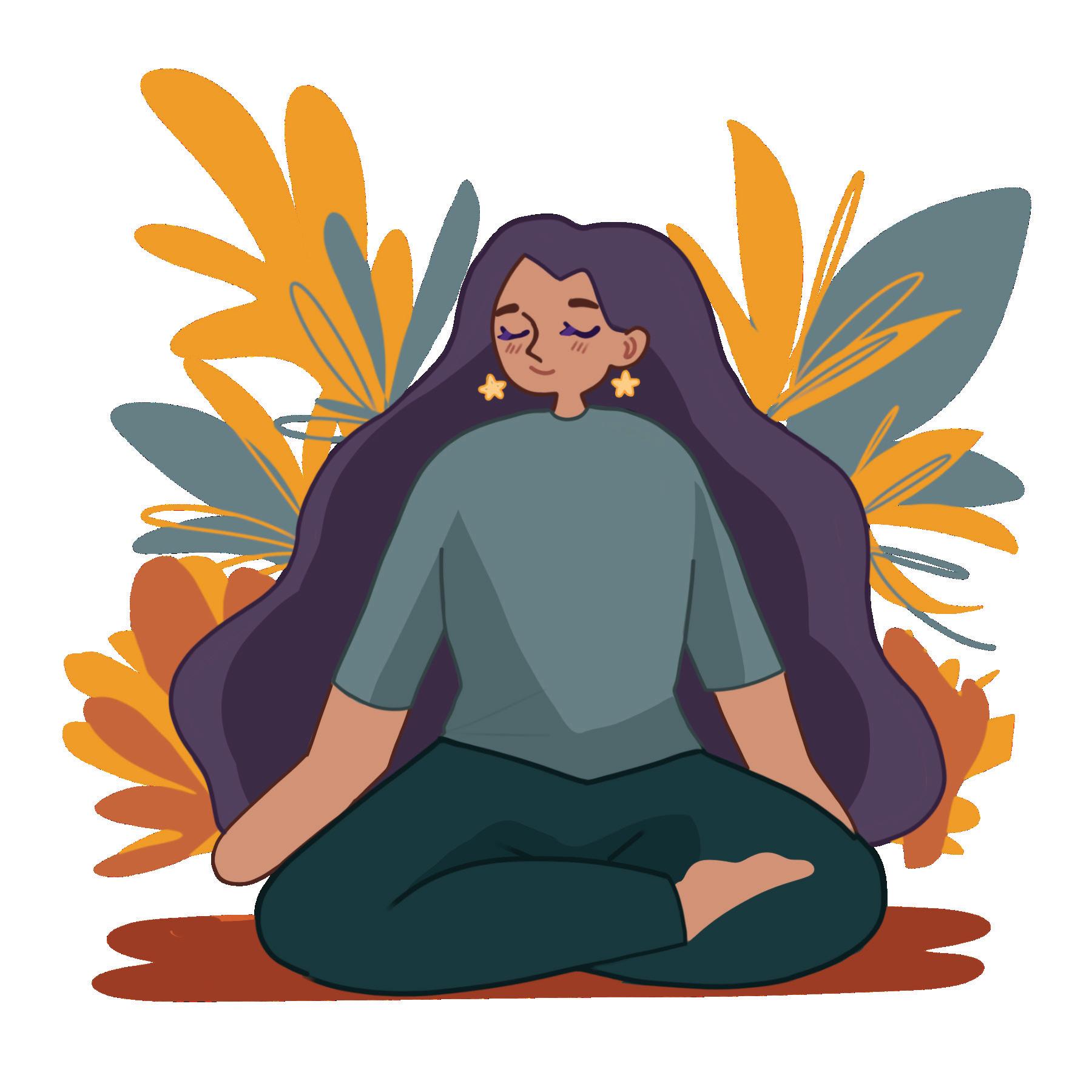
You don’t have to feel completely comfortable spending time alone overnight, but it is something you should try. Even if it’s small steps like spending time alone studying in a co ee shop to eventually seeing a movie or spending a night alone, you’ll eventually get there. It’s hard to get started, but try


the water. You’ll be better o for it– more productive, relaxed, and happier.
I used to dread time spent alone. I would call friends to fill up the space and do anything to take my mind o of my loneliness. I would fill my schedule with plans just to avoid the feeling. But, I realized I was avoiding a bigger problem– I wasn’t taking care of myself mentally, emotionally, or physically when I needed to. Now, I value my alone time immensely. I always set aside nights that are just for myself, so I can reflect, finish some chores, follow my creative pursuits, and sometimes just sleep. The more I valued this time, the more I craved it. I, of course, love people, but I need this time to recharge. Time alone is not something to fear; rather, it is something to hold near and dear to your heart.
17 THE WAKE
Solitude is not as scary as it seems– it can be rewarding and healthy.
2
Existential Terror and You
A Guided Meditation on Deterioration
BY QUINN MCCLURG
Since more than a year ago, I have been hyper-fixated on two words and their similarities: “apoptosis,” from the Greek “falling o ,” defined as the intentional death of individual cells as a means of continuing the collective’s growth, and “apotheosis,” from Greek “make god of,” defined as deification and the highest point of achievement or being.
Around the same time, I su ered multiple unique injuries and diagnoses: two concussions, some broken ribs, and two general heart dysfunctions (arrhythmia and a mitral valve prolapse). For months, I constantly feared internal hemorrhage, imminent death, or never returning to baseline health at all.
In the face of constant existential terror, the mind-body duality faded: existential terror wasn’t in the body, but it was the body, was the flesh, was the mind. Although this may sound pessimistic, the same is true for the rest of us: No matter how fast we run, the biological clocks of our bodies will always be running faster, sprinting toward age, entropy, and deterioration.
Knowing this is unpleasant; in order to stay comfortable, we try to interrogate ourselves through research, exercise control over our bodies and minds, or simply forget what we are. But no matter what method one takes, one still is. Well, I was; injured as I was, I was still conscious. As long as I was and was conscious, I gleaned, I was still whole; as long as I was whole, I had no choice but to keep moving forward in whichever ways I could (I didn’t have any other choice). So I started the process of convalescence.
Unknowingly, it seems, I answered the questions of my previous hyperfixation: apoptosis and apotheosis seem so similar because they are the same process: through death, through loss, through intentional and internal action, we become stronger, defiant, continued. Even if we do not grow, we are still continued, still are; sometimes that is all we can be.
So in the words of Saintseneca, keep living o every scrap of yourself, and “Take solace in knowing (as somebody else) / Though time will tear our bodies o / The you that I knew will not be forgot / No the you that I knew will never be lost.”
A Double Standard in Women’s Basketball
Angel Reese took the world by storm
BY ZOE MEYER

The NCAA Women’s basketball tournament had record breaking attention this year with stars like Catlin Clark of Iowa putting up the first ever 40 point triple-double in division one tournament history (men or women’s). Clark showed dominance in her stats, but also in her infamous trash talking towards other teams. In games Clark waved her hand in front of her face in a tribute to John Cena’s ‘you can’t see me’ taunt, and waved o players she was guarding insinuating they don’t even deserve the respect of her defense.
Controversy arose when following LSUs victory over Iowa in the final, Angel Reese, LSU star, taunted Clark by mimicking Clark’s hand waving and pointing to her own ring finger where shortly the championship ring would be placed. Unlike commentary on Clark, posts on social media called Reese “classless” and “disrespectful” for her actions.

Why is taunting and trash talking acceptable when a white player like Clark does it, but not when a Black player does the exact same thing? Why are men excused or even celebrated for their “passion” in games, but the same privilege is not extended to the women’s game?
Leading up to the final game, LSU stated that they did not like the way Clark was playing or acting towards other teams and they were determined to shut her down. After doing exactly that, keeping Clark to 31 points and beating Iowa by almost twenty, why is Reese chastised for celebrating that enormous feat?
In a post game interview Reese said, “I don’t fit the narrative. I don’t fit in a box that y’all want me to be in. I’m too hood. I’m too ghetto. Y’all told me that all year. But when other people do it, y’all say nothing,” she added. “So this was for the girls that look like me”.
18 APRIL 25 – MAY 1
How
VOICES 2 4
Ask Gracie
Thank you for willingly letting me tell you what to do <3
BY GRACIE KIBORT
I sometimes feel easily irritable and need to separate myself from my close friends. Sometimes irritation is warranted, but other times, it’s not, and I feel bad for ignoring them. What should I do?


My sister recently described me as one of two things: filled with intense rage or splendidly chill. Although I may appear cool, calm, and collected via your recent copy of The Wake, I am usually crotchety at best. More often than not, I am frequently and easily irritated. When I catch myself snapping one too many times at those in my close vicinity or exhibiting hermit behavior to avoid biting the heads of loved ones, I induce a moment of brutal honesty. “Hey girl, I know she’s been humming all day, and your sweater is itchy, and you hate everyone now. But it isn’t the dishes in the sink that make you so angry, what is going on?” Crack open that journal or head out on a walk, for there is thinking to be done. Selfawareness is key People are annoying, boy, do I agree, but in this case, I recommend you redirect that negative energy just floating around your head back into yourself.
people who love you. Listen to Melodrama on repeat. Love yourself as you love him. You are everything: he is Ken. Write!! Cry!! I love you!
I am working on applying to master’s programs and jobs and what I’m going to do after graduation, and am stressed about the timing of everything in my life and about the “typical” postgrad path. How do I move forward and accept that the typical path isn’t for me without feeling stressed about what I “should” be doing?
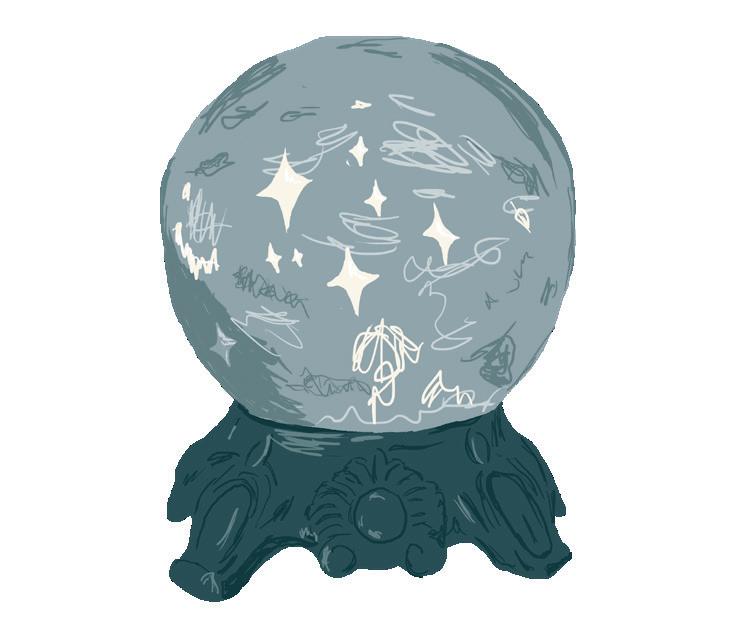
First, I want to congratulate you on getting this far. Graduating is not an easy task. Second, I’m going to ask you a question. What is a typical path? As graduation plummets toward me, I have friends pursuing many choices. Some continue their education, some move in with significant others, and some buy one-way tickets out of the Midwest and call it a day. No single path exists. Some days, the horror of the future ultimately consumes me and I feel pain. I wish part of my gig bestowed on me a gaudy crystal ball so I could peep into
Gracie! I used to love books! Now, my attention span is nonexistent. Where do I start?
This is the question of my dreams. As a child, I practically inhaled books. Somewhere along the way, whether it be raging undiagnosed ADHD or just an apathy that now just makes me sad, I stopped altogether. At some point in the dark ages of 2020, I picked up my mother’s old Kindle and have yet to put it down. I read 33 books last year by putting these tips to good use.
• Don’t know where to start? Recall books you enjoyed as a child; maybe call your mother and find a typical genre. Whoever said you can’t enjoy YA as an adult is wrong, stupid and I hate them.
• This is a Booktok, Audible, and Amazon Hate Club! No, I will not elaborate further. Shop local!

How
do I get over a boy I’m in love
with?
I’m sending you a big squeeze!
First, find a therapist and block him. What do you mean you haven’t already blocked him?!
The greater the distance, the better. Do not try to make him jealous; it will just hurt you more. Spend time around
your future. However, alas, I implore you to dig deeper into your wants and needs rather than the concerns of others. We are going to be okay!
• Don’t know how to stay consistent? Find your happy medium. Read 10 pages daily, set a timer, detach your phone from your hand, and immediately download Libby.
• My holy trinity: Emily Henry, Joan Didion, Nora Ephron.
• Tomorrow and Tomorrow and Tomorrow by Gabrielle Zevin
• Everything I Know about Love by Dolly Alderton
• Writers and Lovers by Lily King
• Tiny Beautiful Things by Cheryl Strayed Happy reading!
19
VOICES 3 3 3 3
Live at Bush Hall
Black Country, New Road
BY ABBY VELA
The progressive, art-rock group Black Country, New Road shows a new side to their sound in their latest release, “Live at Bush Hall.” Having parted with the lead vocalist for their two previous releases, the UK band has taken the opportunity to both experiment with their storytelling and prove their endurance as a creative sensation—no matter the front person.
It was a shock to many when Black Country announced in 2022 that they would play live sets of solely unrecorded songs. With the massive success of both “For the first time” and “Ants From Up There,” the latter being named as one of the best releases of 2022 by critics and listeners alike, it felt like a bold choice to forgo their previous content completely.
“Bush Hall” takes a step toward something increasingly joyful, increasingly happy, then we’ve seen from Black Country, New Road thus far. Of course, you get those twinges of nostalgic longing, but it’s framed in a way that makes you want to cry tears of joy (I know I have). The album starts strong with the beautiful anthem, “Up Song,” a reflection on how far the band has come, their friendships, and how the members are forever tied to each other through their experiences. It’s joyous, fun, and makes you want to sing along at the top of your lungs— “Look at what we did together, BC, CR friends forever! <3”


“The Record”
Boygenius
BY CAROLINE RAY
After much anticipation, Boygenius has released their debut album, “The Record,” but to a mixed response. While Rolling Stone has given it the prestigious stamp of an “instant classic,” fans have been outspoken about their disappointment, with a particularly cutting Twitter review calling it “chatbox music to be sold in the vinyl section at Urban Outfitters.” The internet is divided between devotional love for their favorite indie girl band and disappointment at what they deem a mediocre sell-out album.
As a long-time fan of all three artists, I couldn’t help but love it. While perhaps nothing revolutionary, the album is Julien Baker, Phoebe Bridgers, and Lucy Dacus doing what they do best: cutting and sharp lyricism combined with haunting vocals and clean instrumentals, all with simple precision and heart. The band has lost some of the grittiness and existential dread that defined their self-titled EP, Boygenius while evolving into a more polished and mature sound that reflects their personal and professional growth.
The album holds the same emotional depth that Boygenius is known for while evading the youthful despair of previous releases. The tenderness of the album reflects the connection between the members and speaks to the universal pains of maintaining long-term relationships, specifically female friendships. In the standout song of the album “True Blue,” the three musicians belt in sorrowful harmony, “But it feels good to be known so well.” Like the rest of the album, “True Blue” contrasts the love and pain of intimacy, growing apart, and coming back together in its uniquely strange and beautiful way.

The Super Mario Bros. Movie
Definitely not the 1993 one
BY QUINN MCCLURG
If you haven’t seen this movie yet, I’ll start with two truths and a lie:
1. A character has the GameCube start-up jingle as a ringtone.
2. Bowser belts out multiple lusty jazz piano ditties.
3. Untold thousands perish near the film’s climax.
Cast your vote and…I fooled you; all of these options were correct. Honorable mention: a recklessly nihilistic character quotes Kurt Vonnegut while accepting dying in prison. Ahem.
The Super Mario Bros. Movie was released on April 5, being the first collaboration between the video game company Nintendo and the animation studio Illumination to grace the silver screen.

The runtime is a standard hour-and-a-half, but it does not overstay its welcome, featuring flashy, platformer-inspired fight scenes, gorgeous landscapes and scenery, and enough deep cuts and references toward Nintendo franchises to keep even the most knowledgeable fans surprised.
The first of my minor gripes with this film is that the choices for voice acting were confusing at first but easy to get used to, and my second is that Luigi gets little to no screen time. I believe that Luigi has always been the stronger character of the two, but that is also because I, a little brother, was conditioned to believe so.
Having grown up playing Mario games, I found this film to be a wonderful little romp through the Mushroom Kingdom; however, it was clear that the target audience was intended to be younger children, especially with Illumination in the copilot’s seat. There is little to no character development, and the plot is nothing outside the ordinary in regards to most Mario media, but I didn’t mind; seeing some classic Mario hijinx and a training montage overlaid with Bonnie Tyler’s “Holding Out For A Hero” was enough for me, and I hope it will be enough for your inner child too.
20 APRIL 25 – MAY 1 SIX REVIEWS
Red
Hot Chili
Peppers 2023 Tour
Featuring King Princess and The Strokes
BY MARIE RONNANDER
I arrived at the US Bank Stadium in broad daylight, surrounded by every age and aesthetic. From my left, my roommate whispered a thought that truly embodied the atmosphere: “I feel like I’m at Disneyland.”
As we pulled into our seats, the first opener, King Princess, was already center stage in a neon Hawaiian shirt. Her voice is low and smooth, but the lights are bright, and people are milling around chatting about merch. There was a strange sense of agoraphobia creeping in on me; songs so deep-seated needed to hug their audiences.
An hour later, The Strokes took the stage. This band’s songs have lived in my heart for years, collecting nostalgia. Their performance, while played perfectly, emptied my sense of admiration. Julian Casablancas’ asides were pithed and devoid of attachment for the people around him. While I still cherish the memories written with the lyrics, I can’t forget the vanity emanating from the stage.
When the Red Hot Chili Peppers bassist, Flea, pulls up to the concert in a purple kilt and Vikings-colored socks, the venue becomes a home. Between songs, he giggled about target nose shavers and chirped authentic thank yous to fans. They paused for intimate improvisations that flowed smoothly to their setlist. There was history written into the lined faces of the band members. They were playing their music to tell a story.
While I can’t say I came to the concert knowing more than seven RHCP songs, I can say I appreciated every moment they gave to their audience.

“Rat Saw God”

Wednesday
BY ABBY VELA
A turbulent listen, the North Carolina band, Wednesday, has released their latest album, “Rat Saw God.” This release is a gorgeous and painful follow-up to their 2021 album, “Twin Plagues,” playing with nostalgia and childhood trauma themes. However, “Rat Saw God” builds upon these themes and dares to comment on questions of love and loss, heartbreak, drug abuse, and pain. Although this album provides no answers, it indeed fails beautifully.

Wednesday is known to bend and transform the lines between genres. Combining sounds of country, shoegaze, and straight-up DIY, this new album leans into the weird. Their first single, “Bull Believer,” is my favorite on this album and is an eight-and-a-half-minute beast that combines Sonic Youth’s overdrive with a building, repetitive cries for help. And in true Wednesday fashion, songs like “Bath County,” “Hot Rotten Grass Smell,” and “Turkey Vultures” use unconventional chord progressions and fundamental changes that shock you into a trance, combined with the complex vocal melodies of Karly Hartzman, it’s near impossible to guess where each song leads you. It’s an evolved-yet-uncontrolled chaos.
One of the release’s highlights for me has to be the lyricism. Each song feels like a black-andwhite photo of a rust-belt town. “Quarry,” for example, o ers vignettes of broken, rural life from the writer’s perspective, watching their community hurt itself. It’s heartbreaking, and it’s breathtaking; there’s a palpable sense of the love, care, and pain that the lyricists feel toward their pasts.
I mean it sincerely when I say that I think this may be the best album released this year thus far, and I’m confident that this may be the best album of the year. I cannot recommend “Rat Saw God” enough.
“Welcome To Tha Carter” Tour
Lil Wayne
 BY ROGAN ISBELL
BY ROGAN ISBELL
Dwayne Carter, better known as Lil Wayne, started o his “Welcome to Tha Carter” tour Tuesday evening at the Fillmore. Despite being one of the biggest rappers in the world, all of the shows on this tour are smaller venues to create a more intimate experience.
Wayne has infamously no-showed at previous Minneapolis shows, but this performance made up for it. He was rapping his songs all from memory with no background vocals. Instead, he performed with a live band doing drumming and guitar in the background, and he had strobe lights and smoke coming out during certain parts to intensify the experience.
He started with “Mr. Carter,” then went into a mix of songs old and new, casual and deep cuts. He only performed one verse, and the chorus for most songs performed much of his catalog. The crowd certainly didn’t mind, as he was energetic and having a lot of fun moving around the stage.
Following a short break to let some artists on his Young Money label perform, he returned and performed some of his guest features and songs from his lesser-known mixtapes before ending with the fan favorite “A Milli.”
Wayne has a song called “Best Rapper Alive,” and not many people can call themselves that without any scrutiny. But between the legacy he’s built over his career and this legendary performance, he can back it up. This was an amazing show dedicated to real hip-hop fans I’ll never forget.
21 THE WAKE SIX REVIEWS
Killed by Kiwis
BY PETER NOMELAND
Killed by Kiwis is a Minneapolis-based rock band consisting of six friends who met in high school and worked at the same restaurant. The members include Griffin Baumann on guitar, Simon Midtbo on bass and vocals, Quinn Siebers on drums, Annie Thoma on lead vocals, Frankie Carlson on guitar, and Eli Haugland on synthesizers. They recently headlined the Wake’s annual fundraising concert, aWake After Dark. The group sat down with us to discuss their formation, the songwriting process, releasing music before ever performing live, and Jager bombs.

: How did you guys start as a band?
Quinn Siebers: So it initially started as a threepiece with Simon, Gri n, and I. This was back in high school when we all went to the same school and worked at the same restaurant. And we were kind of just playing around with music, trying to find our sound, and it kind of just came out as more like punk music. And one day, Gri n asked me, “Hey, what should our name be? We haven’t found a name yet.” Earlier that day, I was listening to Trampled by Turtles, so I kind of just made a similar one on the spot, Killed by Kiwis, and the placeholder name just became the name.
Frankie Carlson: The rest of us joined that summer during COVID. So we would meet up in Quinn’s garage, masked up as far away as we could, and just started messing around with di erent sounds. We kind of were just playing with, ‘What do we want to play, and how do we let our own personal influences and musical interests shine through
in what we were doing?’ And it was a really fun process. We definitely became really [close]; we were friends before. We all worked in the same restaurant. Some of us have known each other for longer, but that summer, we just got close. We’re like, ‘yeah, we want to do this. We want to make this band.’ This has been the best part of our lives for the past year and a half because stuck inside and all that. And that’s when we started writing the songs that ended up going on our first album, “Unravel”.
: With such a big group, how does your writing and recording process work?
Q: I’d say it’s a semi-democratic process. Basically, I think someone always brings something at a minimum. There’s always one ri or one set of chords that someone brings. There are a couple of songs that are newer that we’ve kind of just made up while playing. And then we kind of jam out and just make it right that day. But I think more
22 APRIL 25 – MAY 1 Q & A
1
frequently, someone brings an idea, and that idea can be as small as four chords or as big as I have the whole idea for what this song is going to be, and, ‘I have the sections built out, and I might have some ideas for what you want to do.’
F: Songwriting is a muscle. You work it, and it gets a little easier over time. You get stronger at it. At two albums now, we think we’re kind of finding our songwriting style. Something we’ve kind of brought up is these first two albums we love, we pull so much work on ‘em. They took literally years to make, but it’s now that we’re the stu we’re working on, and the unreleased, unreleased music that we’re kind of cooking up at the moment is what Killed By Kiwi’s sound is going to be.
Eli Haugland: Another big reason we’ve found our sound recently is that we’ve actually started practicing every week. During the first two years, we would have practiced during the summer and during winter break sometimes if we weren’t recording actively. And then, during the normal school semesters, because almost all of us were in school and in di erent states, it was almost impossible to travel for practice.
: What has performing as a relatively new band been like?
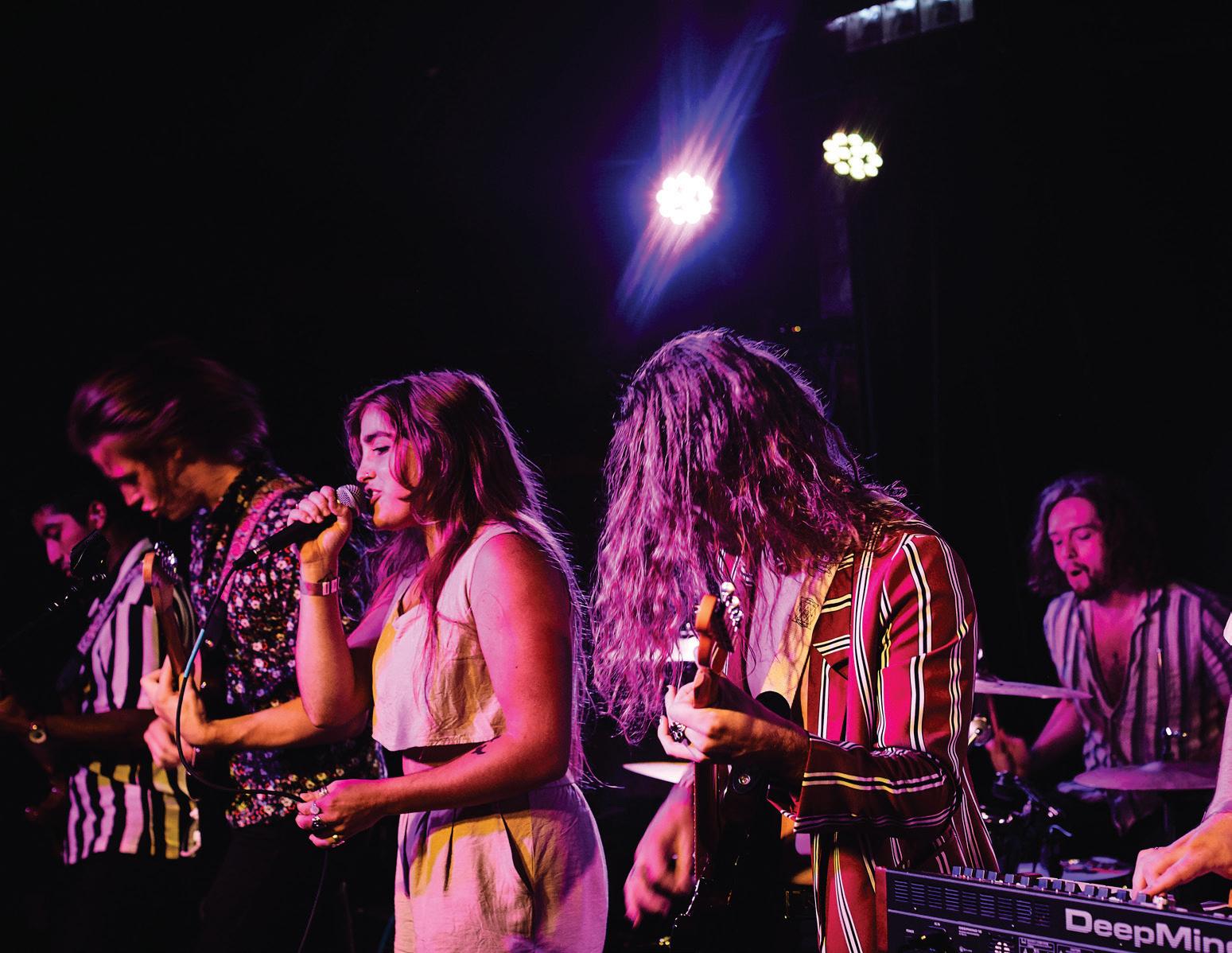
F: Our first performance, the first show we ever played, was at Tap Society, which is a restaurant that was in the building that Kings, the restaurant we all worked at, used to be. We played a show in the driveway of that and kind of like a Porch Fest. And set up sound ourselves and played with our
friends. And that was the first time we had ever played. This was after where we released Unravel. We had put out music before we ever performed live, so it was definitely scary. And I think we definitely had a lot of excitement but also a lot of anxiety about it. ‘Cause we just didn’t know how it was going to go. But most importantly, it was just a lot of fun.
Performing, I think I can speak for the group, is our favorite thing to do in the world now since that show. We’ve just kind of just been trying to play as consistently as we can while working around people being at school and whatnot. But we’ve definitely been trying to hit it harder now that most of us are in town in Minneapolis, and we’ve been able to grow so many wonderful connections and make so many friends through gigging we have.
Annie Thoma: I remember the first show that we played. I didn’t think that many people were going to show up, but there were a lot of people. And I remember being in the alleyway calling my mom crying, and then the whole show, I stared at people’s feet because I couldn’t look at anyone. But yeah, now being on stage is just the best feeling in the world.

F: We have a little family tradition of, at this point, a Jager bomb before every show. And Annie would always abstain and just have a drink or two to loosen up, just to get in the zone. But recently, at our most recent show at the Turf Club, Annie did a Ye bomb with us for the first time.
A: Then I got on stage, and I was like, ‘oh my God’ (laughs). This is going so well.
23 THE WAKE Q & A
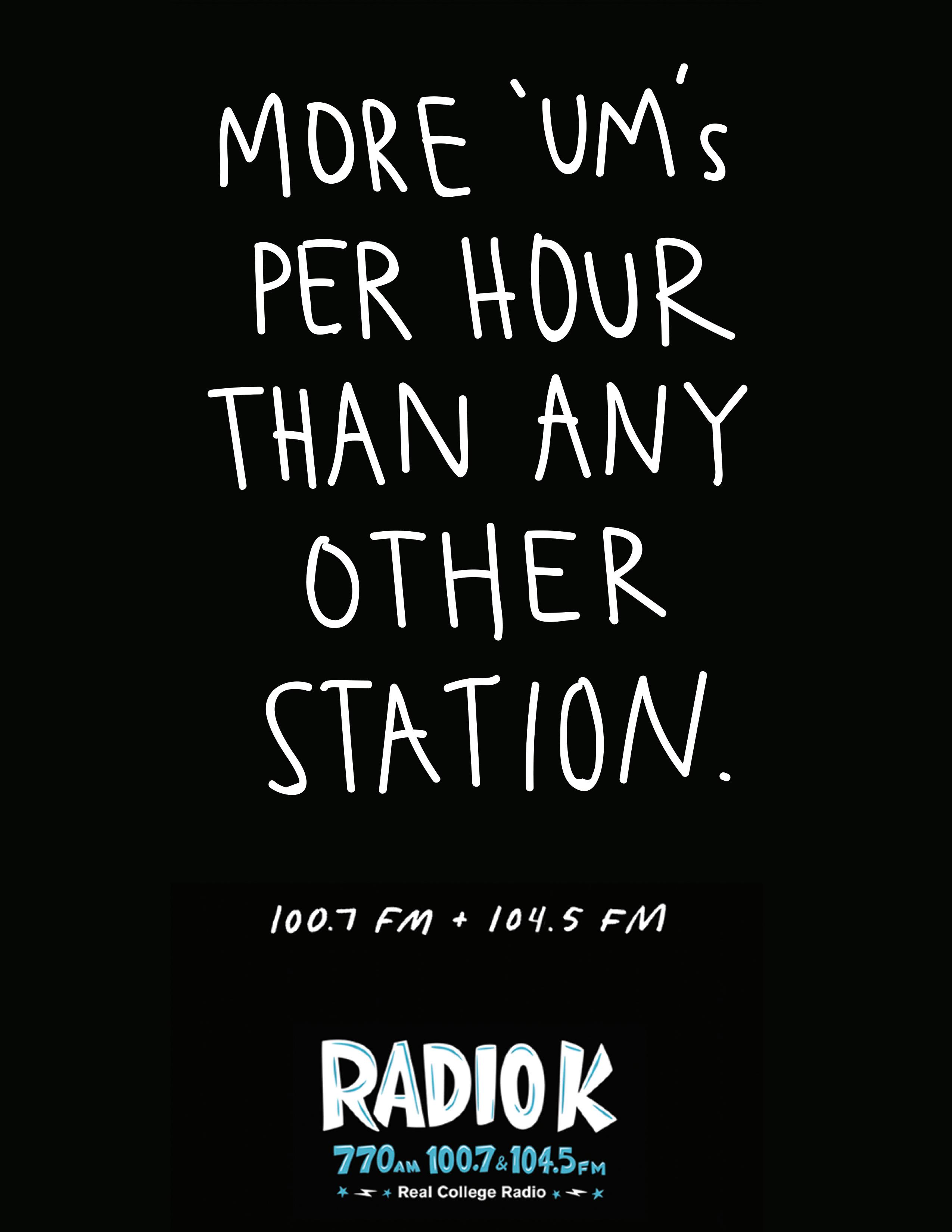





 BY SRIHITA RAJU
BY SRIHITA RAJU
























 BY ROGAN ISBELL
BY ROGAN ISBELL



